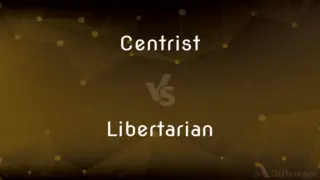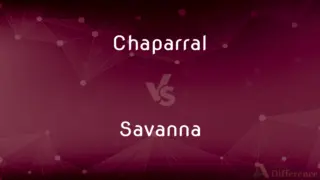Chinese vs. Filipino — What's the Difference?
By Tayyaba Rehman — Updated on September 19, 2023
Chinese pertains to China, its people, or language. Filipino relates to the Philippines, its inhabitants, or language. Both represent distinct Asian cultures and languages.

Difference Between Chinese and Filipino
Table of Contents
ADVERTISEMENT
Key Differences
The term Chinese typically refers to things that are of China, a vast country in East Asia with a rich and ancient history. China's culture has spread influence across Asia and beyond, mainly through trade, art, and its expansive dynastic past. The language spoken in China, primarily Mandarin, belongs to the Sino-Tibetan language family.
On the other hand, Filipino is indicative of the Philippines, an archipelago in Southeast Asia. This nation has a diverse cultural tapestry, influenced by indigenous traditions, Spanish colonization for over 300 years, and interactions with neighboring Asian countries. Filipino, the national language, is based on Tagalog and incorporates words from various languages due to its colonial history.
Chinese cuisine, known globally, is marked by its flavors, techniques, and regional varieties like Cantonese or Szechuan. The Great Wall, Confucianism, and the Chinese zodiac are just some symbols of China's profound cultural imprint. In contrast, Filipino cuisine boasts dishes like adobo and lechon, and the country is renowned for its hospitable people, beautiful beaches, and the Barong Tagalog attire.
The languages also have stark contrasts. Chinese uses logographic characters, and its tones can change word meanings. In contrast, Filipino, written in Latin script, is phonetic and integrates Spanish, Malay, and indigenous words.
Comparison Chart
Geographical Region
East Asia
Southeast Asia
ADVERTISEMENT
Language Family
Sino-Tibetan
Austronesian
Cultural Influences
Indigenous, Buddhist, Taoist
Indigenous, Spanish, Malay, Chinese, American
Script
Logographic characters
Latin script
Major Festivals
Chinese New Year, Mid-Autumn Festival
Sinulog, Ati-Atihan, Pahiyas
Compare with Definitions
Chinese
Reflecting the art, culture, or history of China.
The museum had a rich collection of Chinese artifacts.
Filipino
Representing the traditions or history of the Philippines.
The exhibit displayed Filipino crafts and textiles.
Chinese
Of or relating to China, its people, or its language.
The Chinese delegation visited the summit.
Filipino
Of or concerning the Philippines, its people, or its language.
The Filipino community celebrated Independence Day with fervor.
Chinese
Pertaining to the culinary dishes of China.
They went to a restaurant serving authentic Chinese cuisine.
Filipino
A person from the Philippines or of Filipino descent.
The Filipino artist showcased his work globally.
Chinese
A person native to or a citizen of China.
The Chinese traveler shared tales of Beijing.
Filipino
Associated with the culinary dishes of the Philippines.
The family relished the Filipino dish, kare-kare.
Chinese
The Sino-Tibetan language mainly spoken in China.
She is fluent in Chinese, particularly Mandarin.
Filipino
The national language of the Philippines based on Tagalog.
She writes poems in Filipino and English.
Chinese
Of or relating to China or its peoples, languages, or cultures.
Filipino
Relating to the Philippines, the Filipinos, or their language.
Chinese
A native or inhabitant of China.
Filipino
A native or inhabitant of the Philippines, or a person of Filipino descent.
Chinese
A person of Chinese ancestry.
Filipino
The national language of the Philippines, a standardized form of Tagalog.
Chinese
See Han1.
Filipino
A native or inhabitant of the Philippines.
Chinese
The sole member of the Sinitic branch of the Sino-Tibetan language family, consisting of numerous languages and dialects such as Mandarin, Cantonese, Taiwanese, and Fujian.
Filipino
A person of Filipino ancestry.
Chinese
Any of the Sinitic varieties of speech spoken by the Chinese people.
Filipino
The Austronesian language that is based on Tagalog, draws its lexicon from other Philippine languages, and is the official language of the Philippines.
Chinese
The official national language of China; Mandarin.
Filipino
Of or relating to the Philippines or its peoples, languages, or cultures.
Chinese
Of or pertaining to China; peculiar to China.
Filipino
Of or relating to the Philippines or its people or customs.
Chinese
A native or natives of China, or one of that yellow race with oblique eyelids who live principally in China.
Filipino
Of or relating to the language of the Philippines.
Chinese
The language of China, which is monosyllabic.
Filipino
A native or inhabitant of the Philippine Islands, specif. one of Spanish descent or of mixed blood.
Then there are Filipinos, - "children of the country," they are called, - who are supposed to be pure-blooded descendants of Spanish settlers. But there are few of them without some touch of Chinese or native blood.
Chinese
Any of the Sino-Tibetan languages spoken in China; regarded as dialects of a single language (even though they are mutually unintelligible) because they share an ideographic writing system
Filipino
The official language of the Philippines, based on Tagalog. It draws its lexicon from other Philippine languages.
Chinese
A native or inhabitant of Communist China or of Nationalist China
Filipino
A native or inhabitant of the Philippines
Chinese
Of or pertaining to China or its peoples or cultures;
Chinese food
Filipino
Official language of the Philippines; based on Tagalog; draws its lexicon from other Philippine languages
Chinese
Of or relating to or characteristic of the island republic on Taiwan or its residents or their language;
The Taiwanese capital is Taipeh
Filipino
Of or relating to or characteristic of the Philippines or its people or customs;
The Philippine President
Our Filipino cook
Common Curiosities
Why does Filipino have Spanish words?
The Philippines was a Spanish colony for over 300 years, leading to linguistic influences.
Do Chinese and Filipinos share any festivals?
While they have distinct celebrations, both countries celebrate the Lunar New Year, though traditions might vary.
What script do Chinese and Filipino use?
Chinese uses logographic characters, while Filipino uses the Latin script.
Are Chinese martial arts popular in the Philippines?
Yes, like many places globally, Chinese martial arts like Kung Fu have enthusiasts in the Philippines.
What are Dim Sum and Adobo?
Dim Sum is a Chinese cuisine style with small dishes, while Adobo is a popular Filipino meat marination method.
How have the two countries influenced each other?
Trade, migration, and proximity have led to mutual influences, especially in Filipino cuisine and language.
Are Chinese and Filipino languages similar?
No, they belong to different language families and have distinct scripts and phonetics.
Is Buddhism common in both Chinese and Filipino cultures?
Buddhism is significant in Chinese culture, but the Philippines is primarily Christian, with a minority practicing Buddhism.
Is Filipino based solely on Tagalog?
Filipino is primarily based on Tagalog but incorporates words from other languages.
Is the Philippines close to China?
Yes, they're both in Asia, but the Philippines is in Southeast Asia, while China is in East Asia.
Are there Chinese influences in Filipino culture?
Yes, due to trade and interactions, there are Chinese influences in Filipino cuisine, language, and traditions.
Are Chinese and Filipino both Asian identities?
Yes, both represent distinct cultures within the diverse continent of Asia.
What's the primary Chinese language?
Mandarin is the most widely spoken Chinese dialect.
How do the family structures compare?
Both Chinese and Filipino cultures emphasize family values, though traditions and family roles may differ.
Which has more islands, China or the Philippines?
The Philippines, an archipelago, consists of over 7,000 islands.
Share Your Discovery

Previous Comparison
Centrist vs. Libertarian
Next Comparison
Chaparral vs. SavannaAuthor Spotlight
Written by
Tayyaba RehmanTayyaba Rehman is a distinguished writer, currently serving as a primary contributor to askdifference.com. As a researcher in semantics and etymology, Tayyaba's passion for the complexity of languages and their distinctions has found a perfect home on the platform. Tayyaba delves into the intricacies of language, distinguishing between commonly confused words and phrases, thereby providing clarity for readers worldwide.















































